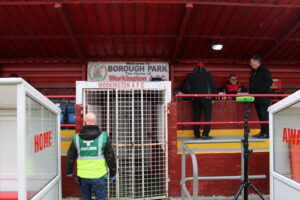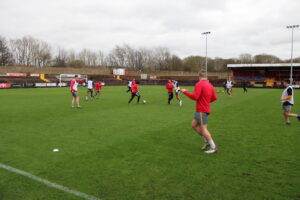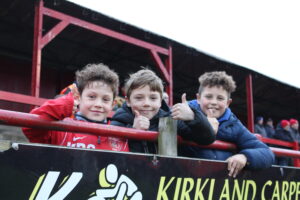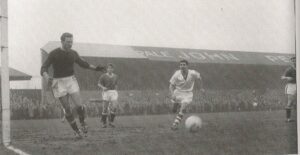65 years on: The story of the Bubsy Babes and their trip to Workington
On January 4th 1958, third division Workington A.F.C. played the football league champions, Manchester United’s ‘Busby Babes’, in the F.A. Cup third round.
Today marks the 65th anniversary of that plane crash.
This is the story of the Babes, the untold history of Workington, and the F.A. Cup tie remembered by those who were there.
A smile beams across Gordon McCallister’s face, who is warming up inside at half-time at Borough Park, home of the step eight Workington A.F.C. The memories of his boyhood club’s golden age roll off his tongue. Stories with names like Shankly, Busby and Burkinshaw all flow freely from his mind despite the fact they all happened over half a century ago.
Their clarity is a sign of those people’s effect on Workington, a town on the Cumbrian coast, a far cry from the hustle and bustle of the big cities that first spring to mind when these three men are brought up.
“There he is, that’s Shankly,” he says, pointing at the seven-foot wall in Borough Park’s executive area dedicated to Liverpool legend and ex-Workington A.F.C. manager Bill Shankly. A fact that, when put in a modern context, seems impossible to fathom.
But then again, football was different in the ’50s.
The mega-teams with mega budgets that we see today didn’t exist. Instead, a maximum wage for players was set, which peaked at £20 a week in 1958 before it was scrapped in 1961 due to the threat of strikes.
Instead of the glitz and glamour of the Premier League that we see today, McCallister recalls a time when men in their thousands would be huddled around at lunchtime in the local factories radio to hear the F.A. Cup draw.
“The canteen was absolutely chocka block. They were going through the teams, and then they said, Workington, there was such a hush. They said we’re playing Man United, and you never heard another thing. The place erupted, cheering and shouting, cheering and shouting. It was a wonderful feeling.”
He tells the story of the unforgettable day that the Busby Babes travelled to Borough Park to play Workington A.F.C. in front of 21,000 people.
To put that number into context, the most recent estimate is that Workington has a population of 25,000. The game was so important to the area that they held ticket ballots in the local schools.
So why all the fuss? What was so great about this Manchester United XI that people were packed into the now illegal terracing so tightly?
Well, the Busby Babes weren’t just any Manchester United XI. Named after their manager, Sir Matt Busby, they won the 1955-56 and 1956-57 first-division titles back-to-back with an average age of just 21.
In comparison, Arsenal, who are the Premier League leaders whilst also being the division’s youngest side, have an average age of around 25.
The side was littered with talent, including Sir Bobby Charlton, who was 20 at the time of the crash. Alongside him were players like Duncan Edwards, Tommy Taylor, and Roger Byrne, all considered some of the best of their generation in England.
As a result, they were expected to go on and win many more major trophies. That is until the crash cruelly took their lives too soon. Along with Edwards, Taylor and Byrne, Geoff Bent, Eddie Coleman, Mark Jones, David Pegg and Billy Whelan all lost their lives.
Edwards, especially, has gone down in United folklore as a tragic example of what could have been.
At the time, he had become the youngest player to ever play in the first division (aged just 16 years and 185 days) and the youngest England player since the end of the Second World War (18 years and 183 days).
This record stood until Michael Owen’s debut 43 years later.
The Busby Babe’s time together may have been cut short by tragedy, but to the hardcore United faithful, they are a team that remains eternal.
“The Busby Babes meant a huge amount to not just the people of Manchester but Manchester United fans. I think even if you weren’t a Manchester United fan you admired them even if you didn’t support them,” said Andy Mitten, founder of the fanzine United We Stand and Manchester United Journalist for the Athletic.
Mitten says that the player’s working-class backgrounds helped them touch the nation’s hearts.
“They were really popular. They weren’t just Mancunians but people drawn from around England. For example, Bobby Charlton came from Ashington, north of Newcastle, Duncan Edwards came from Dudley, and Tommy Taylor came from Barnsley. These are all very working-class places that tend to produce good footballers,” he explained.
These were not the footballing stars that are hidden away in their housing complexes in Cheshire that we see today. Instead, fans would see these men at the pubs after the game. These were everyday people with exceptional talent.
Fitting then, considering their normality, one of the last games the Babes ever played was at a tiny club in a working-class area.

At the time, the Workington Reds were in the Third Division. Later that year, they would be relegated to the Fourth Division, eventually being voted out of the Football League in 1977 and replaced by Wimbledon.
They had never won a championship in any division and would not do so until they won the Northwest Counties League – which is step nine on the football pyramid – in 1998.
The town itself is an old industrial hub, and it was one of the ‘Red Wall’ political seats that voted Conservative in the most recent General Election.
In fact, the media coined the phrase ‘Workington Man’ to describe a working-class voter who voted Tory because of factors like Brexit and Jeremy Corbyn’s leadership of the Labour Party.
In its recent history, Workington has seen a significant economic decline since the local steel and mining industries were outsourced to cheaper foreign producers. Yet, unlike many other ‘Red Wall’ seats in similar situations, it has not seen a mass population exodus.
Despite being from the south, I have a special connection to Workington, as my dad is from there. In addition, I spent most of my half-term school holidays in Workington, staying at my late Grandad Ken’s house.
In fact, the first football game I went to was a Workington Reds game against Blyth Spartans.
As my dad says, it’s easy enough to get to from where I live in London, “just drive up the M1, then the M6, turn left at Penrith and stop before you get wet”, which is precisely what I did to go and watch the Reds play 1874 Northwich F.C.
After the ‘easy’ 5-hour drive, I arrived at Borough Park, home of the Reds since 1937. Mitten pointed out that “it has seen better days in the 1980s.
“You can see the roof of the old main stand, and where they’ve slashed it off. You might not even know it was an old stand there on one side,” Mitten described.
Indeed, Borough Park has significantly downsized. The ground used to hold 21,000 people. However, after the disaster at Hillsborough, the terracing ban meant that the capacity was reduced to 3,101.
The stadium is open and at the mercy of the elements. In addition, Workington is coastal, and the stadium is right on the top of a hill, so the wind howls around the bowl.

As a result, when it rains here – which is almost every other day — the rain smacks you in the face so hard it feels like it’s out to hurt you.
The unique meteorological conditions mean the Reds don’t need to let their opposition know where they are early doors. The weather does it for them.
Consequently, Workington have a very respectable home record, and the 607 fans at the ground on the bitterly cold day I visited were in good spirits.

Despite the fact it was almost 0 degrees, not including windchill, a few of the Reds faithful were in shorts. One such gentleman saw how cold I was and shouted, “You southern Jessie!”
There is beauty in the fact that these fans brave the elements every week to come and watch their local side. This photo, which went trending on Twitter, is a testament to their commitment to the game up here.
https://twitter.com/WorkingtonAFC/status/1613596815659499524
As Chairman Les Byers aptly told me, “this is proper football”.
Despite the rugged exterior that Borough Park may initially display, Workington A.F.C. have a rich history, largely untold to the masses.
The Reds spent many years in the Football League when they saw a few of football’s most influential people pass through their doors.
George Best played for the Reds in a fundraiser in 1986 when Workington were strapped for cash.
Keith Burkinshaw played 293 times for Workington between 1957 and 1965, including the F.A. Cup tie against Manchester United and acting as player-manager for a year in 1965-66.
Burkinshaw became one of Tottenham Hotspur’s greatest-ever managers, winning the second most major trophies of any Spurs manager. He is also famed for signing Osvaldo Ardiles and Ricardo Villa, two of the first South American players to play in the football league.
Amazingly for a club the size of Workington, however, neither of these men is the biggest name associated with the club.
Bill Shankly holds that honour.
Before Shankly began cementing himself into the history of Liverpool Football Club, taking them from the Second Division to three First Division titles, two F.A. Cups and a UEFA Cup, he managed Workington between 1954-55.
His influence on football in this part of the world is still felt at Borough Park and the surrounding area.
“He had no youth team when he came here, and we were down training every Tuesday and Thursday night. So he got one together, and from that he founded the West Cumbrian league,” McCallister informed me.
The West Cumbrian League remains today as the area’s county youth league. McCallister recounted how Shankly was committed to getting the young people of Workington into football, even though it is traditionally a rugby league stronghold.
“He was coming down one Sunday morning to the ground, and there was a gang of lads standing on the corner, and he looked up and said, ‘there’s a football field over there, lads.’
The lads said, “Well what we going to play with?”
Shankly asked, “Don’t tell me you haven’t got a ball?”
They replied, “No,” Shankly said, “Hang on there.”
McCallister smiles and tells me, “So Shankly turned round went back down the hill into the club, got a ball, came back and said, “there’s a ball, that’s yours to keep, now get on that bloody field.”
It was a seemingly small gesture, but one indicative of the type of man Bill Shankly was and why he touched the hearts of many in Workington during his time there.
One man told me that the Liverpool talisman sent the Reds a good luck letter before the game against United, which might have been a factor in their brilliant performance.
At the time of the tie, the F.A. Cup was more important to the nation than the Football League title, a foreign concept to the modern football fan.
Mitten told me, “My uncle Charlie [who played for Manchester United between 1946 and 1950, scoring 50 goals] told me that the F.A. Cup was the most important competition in football, even more so than the league. Of course, it’s not like that now, but it was back then.”
To retell the match, I interviewed John Walsh, a lifelong Reds fan and journalist for a local publication called the Times and Star. Walsh was at the game and remembers it vividly to this day.
“This ground was chocka block, and it was absolute mayhem. The game itself … well, we were leading 1-0 at half-time. My favourite footballer at the time in the Reds team, Clive Coldbridge, scored the opening goal,” he said.
“There was no social media in those days so when the word came out at half-time on T.V. the reaction was ‘woah Man united losing 1-0 at 3rd division Workington’,” Walsh explained.
Converting this into modern terms, it would be as if Forest Green Rovers had taken the lead against Manchester City, who would be playing their best XI.
McCallister informed me Workington had a chance to go 2-0 up through a shot by Billy Robson,”It nearly shattered the crossbar, and I think if that would have gone in then that would have been it for the Reds.”
Yet no such goal came, and Walsh described how Workington were eventually at the mercy of the Babes’ evident talent.

“In the second half, they showed their class obviously, and Dennis Viollet scored a hat-trick meaning they won 3-1. We’d given a very good account of ourselves. Everyone from a Workington point of view was delighted,” Walsh recalled.
However, a good account of themselves seems somewhat of an understatement, especially as the legendary opposition manager was so impressed.
“Matt Busby came into the Reds dressing room, wished them all the best and shook hands with everybody. That’s how much of a gentleman he was. He said, ‘you’re a credit to the game, and frankly, the score flatters us,’” McCallister recounted.
High praise from a man who had and would go on to win everything in football, including Manchester United’s first European Cup title in 1968.
This game is a mere footnote in the history of Manchester United, especially considering their success in the F.A. Cup. Yet, because of the Munich Air Disaster just 30 days later, it will forever be remembered by fans young and old as the Busby Babes’ last F.A. Cup third-round tie.
The Babes were going to be the best of their generation, and football fans around England will never forget them.
May they rest in peace.
For more from our football team, click here.